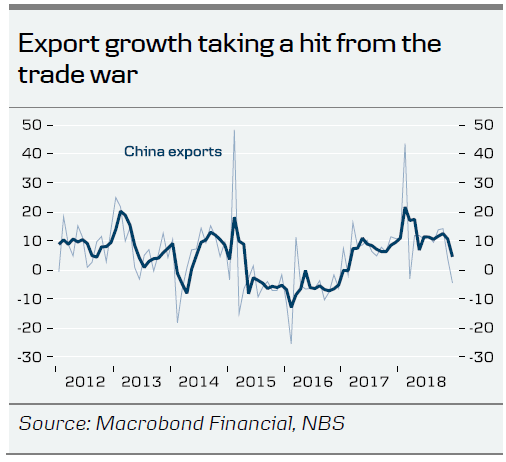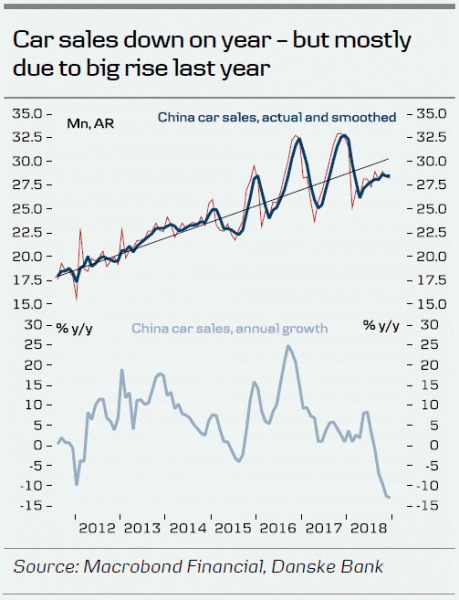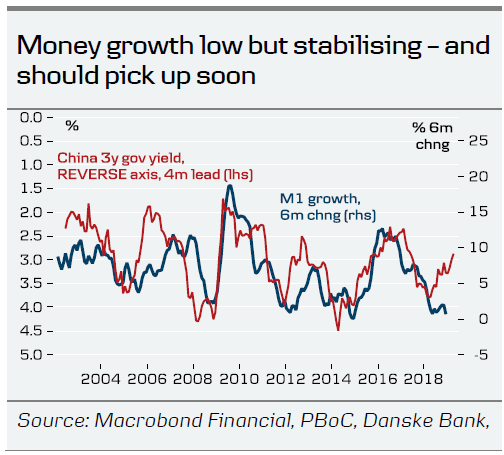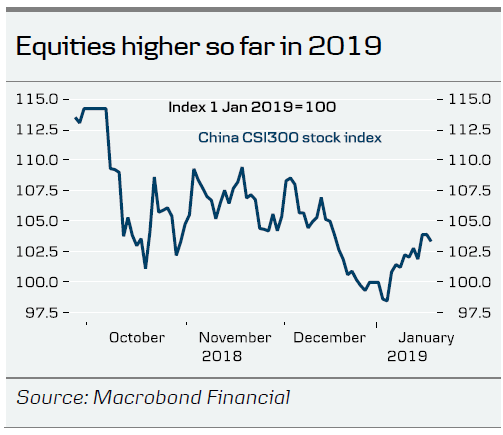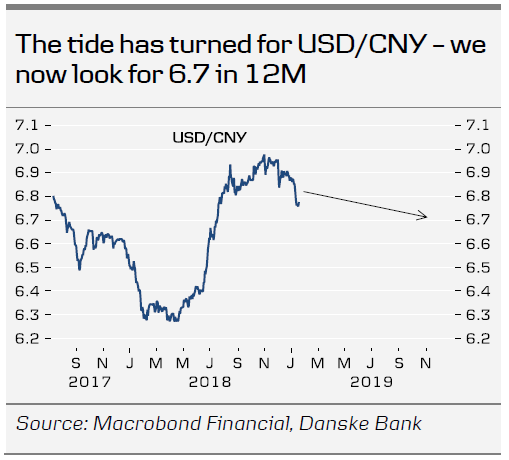- Weak data confirms slowdown – but markets are calm
- US-China high-level trade negotiations confirmed for 30-31 January
- Wall Street Journal story adds to signs that a trade deal is coming
- China announced further opening up for inbound financial investments
More weak data but markets are calm
Chinese trade data for December grabbed the headlines this week. They revealed a big drop in both exports (see chart) as well as imports. A big drop in car sales of more than 10% y/y also attracted attention (bottom chart). Finally, data on money growth (a good leading indicator) was also soft but is stabilising at a low level. Equity markets reacted fairly calmly, however, and actually increased this week.
Comment . It is not a big surprise that the economy weakened further into year-end and a lot of bad news is already priced into equity markets. The weak car sales have to be taken with a grain of salt. The very negative annual growth rate is partly due to the comparison with a very high level at the end of 2017, because a tax break on small cars was removed at the turn of 2017/2018 . In coming months, the annual growth rate of car sales is very likely to shoot higher simply because of the big drop in sales in January and February last year. In addition, the Chinese leadership is said to prepare measures to lift auto sales.
When it comes to money growth, we expect it to move gradually higher soon as monetary easing will start to feed through. The top chart on page 2 shows that lower yields typically translate into higher money growth (and thus activity) with a time lag of three-six months.
We continue to look for the Chinese economy to recover gradually from Q2 as stimulus kicks in with more force and a trade deal is reached by Q2 (75% probability).
High-level trade talks confirmed – Trump wants a deal
This week, China confirmed that top negotiator Liu He will head a delegation to Washington in late January . He will face US Trade Representative and China hawk Robert Lighthizer in the first round of high-level trade talks since the ceasefire started. Talks in Beijing last week was on a lower level and was focusing on Chinese purchases of US goods. The talks between Liu He and Robert Lighthizer are likely to address some of the more difficult issues surrounding China’s industrial policies and technology transfer.
The Wall Street Journal (WSJ) reported on Thursday that in internal strategy meetings, Treasury Secretary Stephen Mnuchin had proposed that the US should ratchet back tariffs on China in a move to pry concessions out of it. The move has been opposed by Lighthizer, according to the article . Maybe as important, the article also states that ‘in past China discussions, Mr. Trump has sided with Mr. Lighthizer on tariffs, rather than Mr. Mnuchin. But this time, the president has made it clear he wants a deal’.
—and is pressing Mr. Lighthizer to deliver one, according to people familiar with the discussions’ (our underlining).
Comment. We believe the WSJ story is further confirmation that Trump is keen on getting a deal with China. He may end up making a deal that is too soft in the eyes of Lighthizer and other hawks. But a deal that involves China buying goods worth up to USD100bn of agricultural products and other goods should be easy to sell to voters as a victory. Not least to farmers in important swing states like Wisconsin, Iowa and Ohio. Trump will point to lower car tariffs, more opening up, increased protection of intellectual property rights and tough restrictions on Chinese investments into the US. Finally, an end to the trade war would be likely give a boost to equity markets, for which Trump could take credit.
More opening-up of FDI and financial flows
In a move of further financial opening, China announced a doubling of the so-called QFII quota to USD300bn for foreign financial investments into China, see SCMP, 14 January 2019. It is a continuation of China’s gradual opening up of the capital account and seen as another olive branch in the trade talks with the US. On Sunday, China’s commerce minister Zhong Shan repeated pledges that China would allow full foreign ownership in more areas and reduce the number of industries in which foreign investment was restricted or barred. See SCMP, 13 January.
Comment. China continues to take steps to open up more and to meet US demands in the trade war. In December, China drafted a new law, which tightens Intellectual Property Rights (IPR) by substantially raising fines for violations. See The Straits Times, 25 December 2018. From 1 January 2019, it was also made possible to take IPR cases to China’s Supreme Court. Last year, China also lowered general tariff rates twice on a wide range of goods (except of course US goods due to the trade war). Both the US and China seem very committed to paving the way for a trade deal.
Other China news
While news on the trade front is mostly positive, US-China tensions are heating up on pretty much all other fronts – not least tech and security. Here are a few stories from the week:
- US lawmakers seek to ban chip sales to China’s Huawei and ZTE for ‘violating American sanctions’, SCMP, 17 January.
- The US and UK navies have joined forces for the first time in the South China Sea, see Business Insider, 16 January.
- China is said to ask state firms to avoid travel to the US and its’ allies, see Bloomberg, 15 January. At the beginning of January, the US warned Americans to ‘exercise increased caution…due to arbitrary enforcement of local laws’.
- Pentagon warns of global power play behind Chinese projects such as Belt and Road Initiative, see SCMP 16 January.
The Canada-China dispute also escalated this week as a Chinese court changed a 15-year prison sentence for a Canadian citizen to a death sentence, see Bloomberg 15 January.
Huawei founder breaks silence to deny US spying claims, see Bloomberg, 15 January. ‘I love my country, I support the Communist Party. But I will not do anything to harm the world… I don’t see a close connection between my personal political beliefs and the businesses of Huawei’.
This week we lowered our USD/CNY forecast to 6.7 in 12 months (from 6.8), see page 15 in FX Forecast Update, 14 January.




